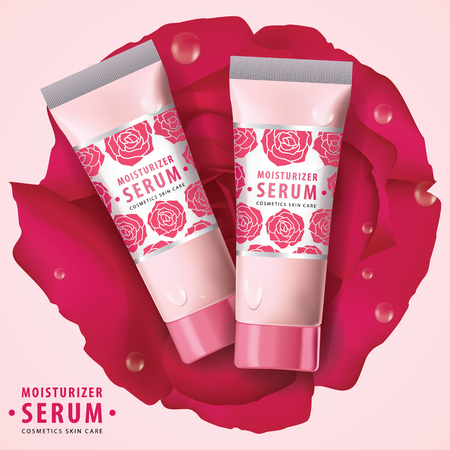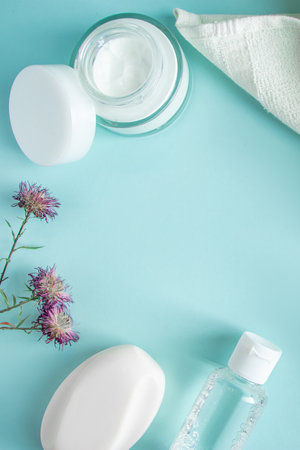1. Understanding the Basics: What Defines Natural and Chemical Cleansers?
When it comes to skincare, the choice between natural and chemical cleansers is a hot topic in the beauty industry. But before diving into which option is better for long-term skin health, its essential to clarify what actually sets these two categories apart. Natural cleansers are typically formulated with ingredients derived from plants, minerals, or other naturally occurring sources. Think botanical extracts, essential oils, or fruit-based enzymes—ingredients you might recognize from your kitchen or garden. On the flip side, chemical cleansers often include lab-created compounds such as sulfates, parabens, or synthetic fragrances designed to deliver targeted results like deep cleansing or acne control.
It’s important to debunk the myth that “natural” always means safer or better for your skin. Many natural substances can cause irritation or allergies, just as some synthetics are carefully engineered to be gentle and effective. In fact, the line between natural and chemical isn’t always black and white—some cleansers combine both types of ingredients to optimize performance and user experience.
Ingredient sourcing and formulation play a crucial role in how these products interact with your skin. Natural cleansers often focus on minimally processed extracts that maintain their original properties, while chemical cleansers leverage advanced science to isolate active molecules and create consistent results. Ultimately, understanding these core differences helps you make informed choices tailored to your unique skin needs—no matter which camp you lean toward.
2. Skin Deep: The Science Behind How Cleansers Affect Your Skin
When it comes to cleansers, the real magic—or mischief—happens right at the skin’s surface. Our skin isn’t just a passive shield; it’s an active ecosystem bustling with beneficial microbes and a sophisticated barrier called the stratum corneum. Understanding how natural and chemical cleansers interact with these elements is key to making smarter skincare choices for long-term health.
The Microbiome & Skin Barrier: Your First Line of Defense
Your skin’s microbiome is a diverse community of bacteria, fungi, and other microorganisms that play a crucial role in keeping your skin healthy and resilient. The outermost layer, the barrier, locks in moisture while blocking irritants and pathogens. How we cleanse can either support or sabotage these defenses.
How Cleansers Interact with Skin
| Natural Cleansers | Chemical Cleansers | |
|---|---|---|
| Impact on Microbiome | Generally milder; tend to preserve natural flora due to gentle surfactants and plant-based ingredients. | May contain harsh detergents (like sulfates) that strip away both bad and beneficial bacteria, potentially disrupting microbiome balance. |
| Barrier Function | Often formulated with oils and extracts that reinforce the lipid layer, helping maintain moisture and integrity. | Certain synthetic ingredients can compromise the barrier by over-cleansing, leading to dryness and increased sensitivity. |
| Irritation Potential | Lower risk if free from allergens; however, some botanicals may still trigger sensitivities in reactive skin types. | Higher risk due to artificial fragrances, preservatives, and aggressive cleansing agents commonly found in mainstream formulas. |
What Dermatologists & Recent Research Say
Emerging dermatological research increasingly points to the importance of supporting the skin’s microbiome for lasting health. According to a 2023 study published in the Journal of Dermatological Science, maintaining microbial diversity correlates strongly with lower rates of inflammation, breakouts, and premature aging. Dermatologists caution that frequent use of harsh chemical cleansers can erode this delicate balance, while gentle natural options are less likely to disrupt it—though not all “natural” labels are created equal.
The bottom line? The science suggests that what you wash with matters as much as what you put on afterward. A cleanser that respects your skin’s ecosystem can make all the difference for resilience and radiance over time.

3. Pros & Cons: Natural Cleansers in Everyday American Life
When it comes to daily skincare, natural cleansers have carved out a significant niche among American consumers who value wellness and sustainability. The appeal of natural cleansers often lies in their plant-based ingredients—think aloe vera, green tea, or chamomile—which are celebrated for their gentle touch on the skin and minimal risk of irritation. Many Americans are drawn to these products not just for what they include, but also for what they leave out: parabens, sulfates, and synthetic fragrances that may trigger sensitivities or disrupt the skin’s natural barrier.
Benefits of Going Natural
Natural cleansers align seamlessly with the growing American trend toward holistic health. They’re typically free from harsh chemicals and are less likely to strip away essential oils, making them ideal for sensitive or dry skin types. Eco-conscious consumers also appreciate that many natural cleansers use ethically sourced ingredients and biodegradable packaging—a win-win for personal health and the planet.
Cultural Appeal and Lifestyle Integration
The cultural shift towards “clean beauty” has transformed natural cleansers into more than just a product choice—it’s a lifestyle statement. For many Americans, choosing a natural cleanser is about supporting brands with transparent ingredient lists, cruelty-free testing, and a commitment to environmental stewardship. This aligns perfectly with broader movements like zero-waste living and mindful consumption that continue to gain traction across the U.S.
Potential Drawbacks to Consider
However, it’s important to recognize that not all natural cleansers are created equal. Some formulations may lack the preservatives necessary to ensure product safety over time, leading to shorter shelf lives. Others might not provide the deep cleansing power required for oily or acne-prone skin, leaving some users searching for additional solutions. And while “natural” can be a powerful marketing term, there is still little regulation around its use—meaning consumers need to stay savvy and read labels carefully.
Ultimately, as American wellness trends continue to evolve, natural cleansers remain popular for their gentle approach and eco-friendly appeal. But making an informed choice means weighing both the advantages and limitations within the context of your own skin needs and values.
4. Pros & Cons: Chemical Cleansers and Modern Skincare Routines
In today’s fast-paced American lifestyle, chemical cleansers continue to hold a strong position in the skincare market. But why do these lab-formulated products remain so popular, especially when natural alternatives are gaining traction? Let’s dive into the strengths and challenges of chemical cleansers, their ability to target specific skin issues, and how science-driven innovations are shaping modern routines across the US.
The Enduring Appeal of Chemical Cleansers
Chemical cleansers are formulated with active ingredients—like salicylic acid, glycolic acid, and benzoyl peroxide—that deliver targeted results. They’re not just about cleansing; they address acne, uneven skin tone, excess oil, and even early signs of aging. This precision is a key reason why dermatologists often recommend them for persistent skin concerns.
Benefits and Drawbacks: A Quick Comparison
| Chemical Cleansers: Pros | Chemical Cleansers: Cons |
|---|---|
| Clinically proven effectiveness for acne and oil control | May cause irritation or dryness if overused |
| Can be tailored for various skin types and concerns | Some formulas contain harsh additives or fragrances |
| Fast-acting, visible results with regular use | Potential for disrupting skin’s natural barrier if not chosen carefully |
| Widely available in drugstores and online retailers across the US | Less eco-friendly due to synthetic ingredients and packaging |
The Rise of Science-Backed Skincare in America
The American skincare industry thrives on innovation. Consumers now look for products backed by research—think dermatologist-tested claims or ingredients proven effective in clinical trials. This scientific approach reassures users about both safety and results, driving trust in chemical cleansers as part of multi-step routines. Whether it’s double cleansing or integrating serums post-wash, Americans value efficacy and customization more than ever before.
The Bottom Line for Your Long-Term Skin Health
Chemical cleansers offer undeniable benefits for those battling stubborn breakouts, pigmentation, or oily skin. However, users should pay close attention to ingredient lists, patch test new products, and balance these cleansers with hydrating and soothing elements within their regimen. Ultimately, the best choice is one that fits your unique skin needs—supported by both science and personal experience.
5. From the Experts: Dermatologists’ Perspectives on Long-Term Skin Health
When it comes to choosing between natural and chemical cleansers, leading American dermatologists emphasize a nuanced approach rooted in evidence-based skin science. According to Dr. Emily Rogers, board-certified dermatologist based in Los Angeles, “There’s no universal answer—what matters most is how your skin responds over time and what ingredients are present in each formula.” She points out that while natural cleansers often skip harsh additives, not all botanicals are automatically gentle or hypoallergenic. For those with sensitive skin or conditions like eczema, Dr. Rogers recommends patch-testing both natural and synthetic options, as even essential oils can be irritating.
Tailored Choices for Diverse Skin Types
Dr. Marcus Lee, a New York City dermatologist who specializes in multicultural skincare, highlights the importance of considering diverse skin needs: “Skin of color can be more prone to hyperpigmentation when irritated. Fragrances and sulfates—found in some chemical cleansers—are common culprits.” He notes that both natural and chemical cleansers can be effective if they avoid known irritants and include hydrating agents like glycerin or hyaluronic acid.
Long-Term Effects on Skin Barrier Health
Experts agree that preserving the skin’s natural barrier is crucial for long-term health. Over-cleansing with harsh chemical agents may strip away protective oils, leading to dryness and increased sensitivity. However, Dr. Rogers warns against assuming all “natural” products are mild: “Some plant-derived ingredients can actually disrupt the skin barrier if used excessively.” A balanced pH and minimal foaming action are key attributes dermatologists suggest looking for in any cleanser.
The Bottom Line from Dermatologists
Ultimately, dermatologists encourage consumers to look beyond marketing claims and focus on ingredient lists, their unique skin type, and long-term effects rather than trends alone. Whether you opt for natural or chemical cleansers, regular consultation with a skincare professional ensures your regimen supports your skin’s evolving needs—especially as seasons change or as you age. The best cleanser is one that maintains clarity, comfort, and overall dermal health without unnecessary irritation.
6. Making the Choice: Personalizing Your Skincare Journey
When it comes to choosing between natural and chemical cleansers, there’s no one-size-fits-all answer—your skin is as unique as your lifestyle and values. Here are some actionable tips to help you confidently navigate the skincare aisle and select products that truly fit your needs.
Understand Your Skin Type and Concerns
Before you buy, take stock of your skin’s characteristics. Is it oily, dry, sensitive, or combination? Do you struggle with acne, redness, or aging concerns? Natural cleansers often appeal to sensitive or allergy-prone skin due to their simpler ingredient lists, while chemical options can target specific issues like acne or hyperpigmentation more aggressively. Knowing your priorities sets the foundation for smart choices.
Check Ingredient Labels Like a Pro
Don’t just rely on buzzwords like “organic” or “dermatologist-tested.” Dive deeper by reading ingredient lists. For natural cleansers, look for plant-based oils, extracts, and essential oils—but watch for potential allergens like citrus or lavender. In chemical formulas, focus on active ingredients (like salicylic acid or glycolic acid) and avoid harsh sulfates or parabens if those are concerns for you.
Align with Your Lifestyle & Values
Your daily routine matters. If you’re always on-the-go, a no-rinse micellar water might suit you better than a multi-step cleansing ritual. Eco-conscious consumers may prioritize cruelty-free labels, biodegradable packaging, or sustainably sourced botanicals. Others might value proven results from clinical actives over all-natural claims. Choose what resonates with your beliefs and habits.
Patch Test Before Committing
Regardless of cleanser type, patch testing is non-negotiable. Apply a small amount to your inner arm or jawline and wait 24 hours to check for irritation or allergic reactions before making it part of your daily regimen.
Embrace Flexibility: Blending Approaches
You don’t have to pick sides! Many Americans blend natural and chemical products in their routines for a balanced approach—using a gentle botanical cleanser in the morning and a targeted chemical exfoliant at night, for example.
Your skincare journey is personal and evolving. By understanding your skin’s needs, scrutinizing ingredients, aligning with your values, and being open to mixing methods, you’ll be empowered to make choices that foster long-term skin health—naturally, chemically, or both.


